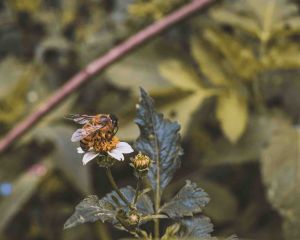HOW MANY DIFFERENT SORTS OF bees can you name? Most people trail off at about two—honeybees and bumble bees—though there are nearly 20,000 different species across the world. Just a tiny fraction of them, however, can cope with urban living, even in city gardens that are bursting with bloom. If it’s not the flowers that are holding back urban bee communities, why do so many of them flourish in the countryside and other natural areas?
The answer, according to scientists from North Carolina State University, seems to relate to higher temperatures in cities and towns. Bees like it to be cool—with yards that are just 3.6°F warmer having a third as many bees as their cooler neighbors. Hot temperatures can be fatal for some species of bees, putting them at greater risk from pathogens or making it harder for them to forage.
For two years, scientists sampled bees in 18 parks and yards across Raleigh, North Carolina, publishing their results in a recent study in the journal Urban Ecosystems. Some yards were warmer, and some were more temperate. Some had an abundance of many different kinds of flowers, and others did not. Bees definitely seem to prefer more flowery yards—but only the largest really appeared to benefit from high floral density. While some species of bees don’t seem to mind a warmer yard, others can’t handle the heat. For those, even the floweriest warm yards are out of the question—no matter how many nectar-heavy blossoms there are.
Still, if you’re trying to get bees into your garden, there are things you can do to help cool it down. Trees help, and so do other kinds of shade. And the more flowers there are, the better. But on a sizzling day, when the asphalt seems on the brink of melting and the sidewalk is almost steaming, well—can you blame the bees for wanting a rural getaway?
BY NATASHA FROST https://www.atlasobscura.com/articles/bees-urban-heat-countryside
FEBRUARY 22, 2018
A wild bee forages for pollen. JAMES LINDSEY/CC BY-ASA 3.0





